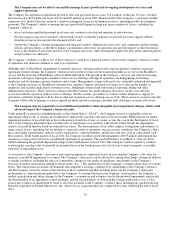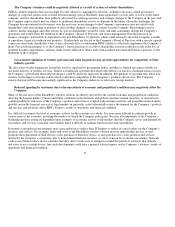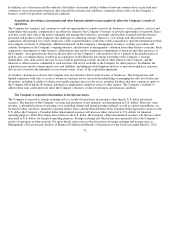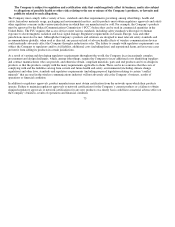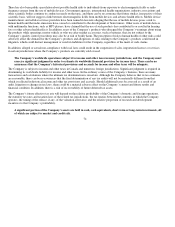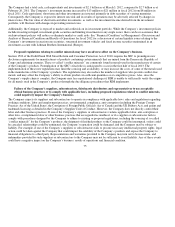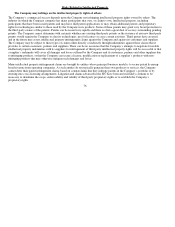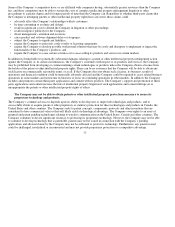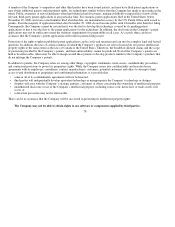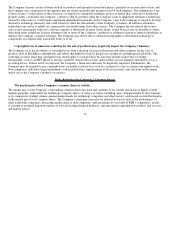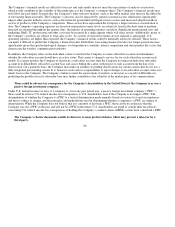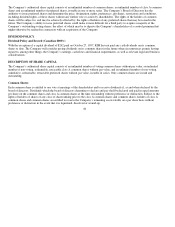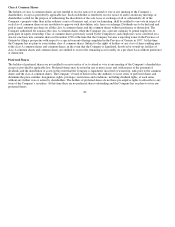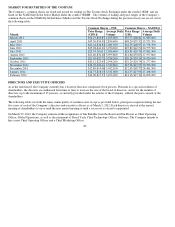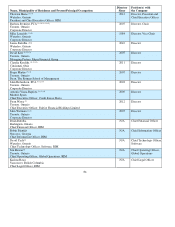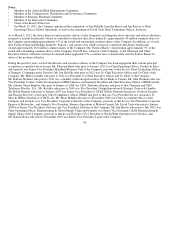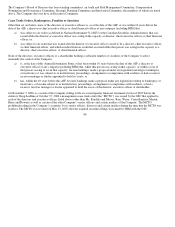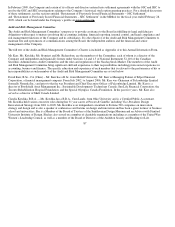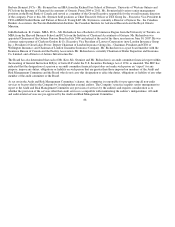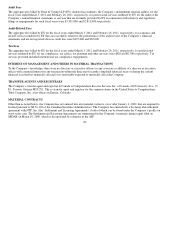Blackberry 2012 Annual Report Download - page 88
Download and view the complete annual report
Please find page 88 of the 2012 Blackberry annual report below. You can navigate through the pages in the report by either clicking on the pages listed below, or by using the keyword search tool below to find specific information within the annual report.
The Company’s financial results are difficult to forecast and such results may not meet the expectations of analysts or investors,
which would contribute to the volatility of the market price of the Company’s common shares. The Company’s financial results may
not follow any past trends. In particular, the Company’s entry into new markets, such as the tablet market, may increase the difficulty
of forecasting financial results. The Company’s sales may also be impacted by current economic factors which more significantly
impact other specific industry sectors, such as the financial, government and legal services sectors and increased adoption in those
sectors of products of the Company’s competitors. These sectors have represented the Company’s largest end user concentration to
date. The Company’s operating expenses are based on anticipated revenue levels, are relatively fixed in the short term to medium
term and are incurred throughout the quarter; thus, fluctuations in operating expenses are likely. Significant unanticipated sales and
marketing, R&D, IT, professional and other costs may be incurred in a single quarter which will affect results. Additionally, many of
the Company’s products are subject to long sales cycles. As a result, if expected revenues are not realized as anticipated, or if
operating expenses are higher than expected, the Company’s financial results could be materially adversely affected. These factors
can make it difficult to predict the Company’s financial results. Difficulties forecasting financial results over longer periods increase
significantly given the rapid technological changes, evolving industry standards, intense competition and short product life cycles that
characterize the wireless communications industry.
In addition, the Company relies on the individual carriers to instruct the Company to create subscriber accounts and determines
whether the subscriber account should have an active status. That carrier is charged a service fee for each subscriber account each
month. If a carrier instructs the Company to deactivate a subscriber account, then the Company no longer includes that subscriber
account in its BlackBerry subscriber account base and ceases billing the carrier with respect to such account from the date of its
deactivation. On a quarterly basis, the Company may make an estimate of pending deactivations for certain carriers that do not use a
fully-integrated provisioning system. It is, however, each carrier’s responsibility to report changes to its subscriber account status on a
timely basis to the Company. The Company’s failure to meet the expectations of analysts or investors as a result of difficulties in
predicting the growth rate in its subscriber base may further contribute to the volatility of the market price of its common shares.
There could be adverse tax consequence for the Company’s shareholders in the United States if the Company is or was a
passive foreign investment company.
Under U.S. federal income tax laws, if a company is, or for any past period was, a passive foreign investment company (“PFIC”),
there could be adverse U.S. federal income tax consequences to U.S. shareholders even if the Company is no longer a PFIC. The
determination of whether the Company is a PFIC is a factual determination made annually based on various facts and circumstances
and thus is subject to change, and the principles and methodology used in determining whether a company is a PFIC are subject to
interpretation. While the Company does not believe that it is currently or has been a PFIC, there can be no assurances that the
Company was not a PFIC in the past and will not be a PFIC in the future. U.S. shareholders are urged to consult their tax advisors
concerning U.S. federal income tax consequences of holding the Company’s common shares if RIM is or has been considered a PFIC.
The Company’s charter documents enable its directors to issue preferred shares which may prevent a takeover by a
third party.
80


